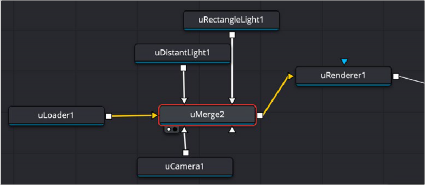< Previous | Contents | Next >
This control allows you to source a USD file to bring into the Fusion project. Use the Browse button to open the file browser and select a USD file (.usd, .usda, .usdc, or .usdz).
Lets you select an In and Out point of a USD file to bring only that range into the Fusion project.
Animated .usd scenes can have their animation speed adjusted to be faster and slower using time scale.
Will define when an animation will start, so timing can be moved along the timeline.
When checked, this will reverse the animation of the USD file.
When checked, this will loop the animation of the USD file.
This button will reload the USD file set in the Filename field above. This lets you make changes to the USD file in another application and see the results in Fusion by reloading it.
Common Controls
![]()
The Settings tab in the Inspector is also duplicated in other USD nodes. These common controls are described in detail at the end of this chapter in “The Common Controls” section.
uMerge [uMg]

The USD Merge node
uMerge Node Introduction
The uMerge node is the primary node in Fusion that you use to combine separate 3D elements into the same 3D environment.
For example, in a scene created with an image plane, a camera, and a light, the camera would not be able to see the image plane and the light would not affect the image plane until all three objects are introduced into the same environment using the uMerge node.
The uMerge provides the standard transformation controls found on most nodes in Fusion’s USD suite. Unlike those nodes, changes made to the translation, rotation, or scale of the uMerge affect all the objects connected to the uMerge. This behavior forms the basis for all parenting in Fusion’s 3D environment.
Inputs
The uMerge node displays three inputs initially, but as each input is connected a new input appears on the node, assuring there is always one free to add a new element into the scene.
— SceneInput[#]: These inputs are used to connect USD image planes, 3D cameras, lights, entire USD scenes, as well as other uMerge nodes. There is no limit to the number of inputs this node can accept. The node dynamically adds more inputs as needed, ensuring that there is always at least one input available for connection.
Basic Node Setup

![]()
The uMerge node combines the 3D USD scene from the uLoader, two light sources, and the camera, then passes that view out to the uRenderer node to flatten into a 2D image.
Inspector
Common Controls
The Transform and Settings tab in the Inspector is also duplicated in other USD nodes. These common controls are described in detail at the end of this chapter in “The Common Controls” section.